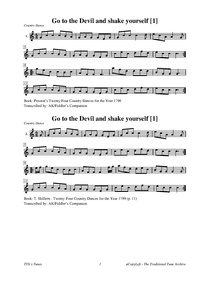Template:Pagina principale/Vetrina: Difference between revisions
No edit summary |
No edit summary |
||
| Line 1: | Line 1: | ||
{{SheetMusic | {{SheetMusic | ||
|f_track= | |f_track=Go To The Devil & Shake Yourself.mp3 | ||
|f_pdf= | |f_pdf=Go to the Devil and Shake Yourself.pdf | ||
|f_artwork= | |f_artwork=Isle-of-Manhattoes-folktale.jpg | ||
|f_tune_name= | |f_tune_name=Go to the Devil and Shake Yourself | ||
|f_track_title= | |f_track_title=Go_to_the_Devil_and_Shake_Yourself_(1) | ||
|f_section=abc | |f_section=abc | ||
|f_played_by=[https://soundcloud.com/ | |f_played_by=[https://soundcloud.com/christopher-hedge Christopher Hedge] | ||
|f_notes= | |f_notes= The isle of Manhattoes and nearby- Folktales: The Rival Fiddlers | ||
|f_caption= | |f_caption=The jig is mentioned in a legend related by Charles M. Skinner (1852-1907) in his book The Isle of Manhattoes and Nearby: the protagonist is a black fiddler named Joost, returning home from playing a wedding on Long Island. He meets a stranger along the road, with a fiddle tucked under his arm, and the two begin to play... | ||
|f_source=[https://soundcloud.com/ | |f_source=[https://soundcloud.com/christopher-hedge/03-go-to-the-devil-shake Soundcloud] | ||
|f_pix=420 | |f_pix=420 | ||
|f_picpix=200 | |f_picpix=200 | ||
|f_article=[[ | |f_article=[[Go_to_the_Devil_and_Shake_Yourself_(1) | '''Go to the Devil and Shake Yourself''']] | ||
The jig is mentioned in a legend related by Charles M. Skinner (1852-1907) in his book The Isle of Manhattoes and Nearby. It is essentially the same story adapted by Charlie Daniel in his song "Devil Went Down to Georgia" about a private fiddle contest between the devil and a human fiddler. In Skinner's tale the protagonist is a black fiddler named Joost, returning home from playing a wedding on Long Island. He meets a stranger along the road, with a fiddle tucked under his arm, and the two begin to play. It quickly escalates into a contest: | |||
<blockquote> | <blockquote> | ||
'' | ''"Where the devil did you come from?" asked (Joost). The other smiled.''<br> | ||
''"And how did you come to know that music?" Joost pursued.''<br> | |||
''"Oh, I've known that tune for years," was the reply,. "It's called 'The Devil's joy at Sabbath Breaking."''<br> | |||
'' | ''"You're a liar!" cried the negro. The stranger bowed and burst into a roar of laughter. "A liar!" repeated Joost,--"for I made up''<br> | ||
'' | ''that music this very minute." ''<br> | ||
''"Yet you notice that I could follow when you played." ''<br> | |||
''"Humph! Yes, you can follow." ''<br> | |||
'' | ''"And I can lead, too. Do you know the tune 'Go to the Devil and Shake Yourself?'"''<br> | ||
<br> | ''"Yes; but I play second to nobody." ''<br> | ||
'' | |||
'' | |||
'' | |||
'' | |||
</blockquote> | </blockquote> | ||
Joost finally bests him at dawn by playing the hymn "Now behold, at dawn of day, Pious Dutchmen sing and pray." With the concession "''Well, that beats the devil''" the stranger strikes his foot against a rock and disappears in an explosion. | |||
}} | }} | ||
Revision as of 17:27, 19 February 2023

Played by: Christopher Hedge
Source: Soundcloud
Image: The isle of Manhattoes and nearby- Folktales: The Rival Fiddlers

Go to the Devil and Shake Yourself
The jig is mentioned in a legend related by Charles M. Skinner (1852-1907) in his book The Isle of Manhattoes and Nearby. It is essentially the same story adapted by Charlie Daniel in his song "Devil Went Down to Georgia" about a private fiddle contest between the devil and a human fiddler. In Skinner's tale the protagonist is a black fiddler named Joost, returning home from playing a wedding on Long Island. He meets a stranger along the road, with a fiddle tucked under his arm, and the two begin to play. It quickly escalates into a contest:
"Where the devil did you come from?" asked (Joost). The other smiled.
"And how did you come to know that music?" Joost pursued.
"Oh, I've known that tune for years," was the reply,. "It's called 'The Devil's joy at Sabbath Breaking."
"You're a liar!" cried the negro. The stranger bowed and burst into a roar of laughter. "A liar!" repeated Joost,--"for I made up
that music this very minute."
"Yet you notice that I could follow when you played."
"Humph! Yes, you can follow."
"And I can lead, too. Do you know the tune 'Go to the Devil and Shake Yourself?'"
"Yes; but I play second to nobody."
Joost finally bests him at dawn by playing the hymn "Now behold, at dawn of day, Pious Dutchmen sing and pray." With the concession "Well, that beats the devil" the stranger strikes his foot against a rock and disappears in an explosion.
...more at: Go to the Devil and Shake Yourself - full Score(s) and Annotations
X:1 T:Go to the Devil and shake yourself [1] M:6/8 L:1/8 R:Country Dance B:Preston's Twenty Four Country Dances for the Year 1798 Z:AK/Fiddler's Companion K:C V:1 clef=treble name="1." [V:1] Gcc cBA|GAG GEG|Gcc c2d|ecA A2G| Gcc cBA|GAG GEG|cec dfd|ecc c3:| |:gec cBc|AFF F3|afd ded|BGG G3| Gcc cBA|GAG GEG|cec dfd|ecc c3:|]
